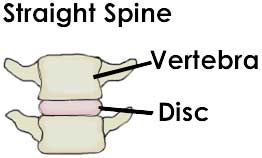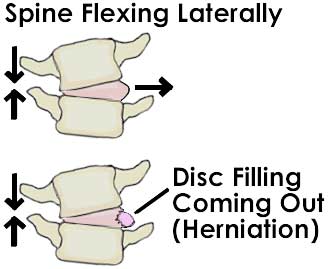Preventing & Recovering From Disc Herniations
Brian Copeland, RKC
February 22, 2007 12:59 PM
The Dreaded ConversationDoctor: "Sorry Brian, but you should consider surgery. I can prescribe pain killers to help you feel better."
Brian: "But what about my martial arts training and I like to lift weights?"
D: "You won't be able to move the same way ever again, you will need to quit martial arts; running, kicking, jumping are all a thing of the past for you. You shouldn't ever lift anything above your head again and don't lift anything heavy"
B: "But I work in a warehouse lifting heavy stuff all day!"
D: "You will probably have to find a desk job somewhere, sorry."
Some of you may have experienced this rather unpleasant conversation like I did several years ago. Based on the fact you are reading this you are not a couch junkie and a Doctor telling you that would be devastating. Thank goodness I didn't listen to that Doctor! Am recommending that you don't listen to Doctors? Listen to your Doctor; he didn't spend 6 years in Evil Medical School to be called Mister thank-you-very-much! But don't listen to just one, not all Doctors are trained and experienced in working with back injuries.
Well I did recover; it took me about 5 years. During that time I had constant back pain, sometimes a minor irritation (couldn't bend and tie shoes without pain) and on at least 5 occasions I would get a shock down my back and spine that put me on the floor unable to get up! I had 2 severe posterior/lateral herniations on my 2 lowest discs in my lumbar region. And if you've ever experienced the pain that goes from the low back, through the hip, down the leg and into the toes, I don't have to tell you that it sucked.
I'm no Doctor but I have been through this, studied, experimented, recovered and have since helped several clients and friends recover from back injuries. The best part about it? I used Party methods!
Herniation BasicsOk, so what the heck is going on down there? Knowing what causes the pain/injury is your first step into figuring out how to fix yourself up. You have to know what NOT to do to incur further injury.

In between each of your vertebra are gel filled discs. They exist to cushion your spine like spongy gel filled shoes (not Party approved) cushion you. Think of these discs kind of like a water balloon. When you are a young child the filling in the disc bladder is liquid. When you are in your middle years the filling of the disc turns to a gel-like substance. In your older years the discs harden and flatten and are no longer liquid or gel-filled. This explains why people shrink an inch or so when they get older. It is during these middle years of your life (20s to 60s generally) you must worry about disc herniations.
So how do you get them? Well that is a complex answer but I'll just say 'abuse' is how you get them.

The reason we keep a straight or arched back during swings, deadlifts and well, everything else is because when the spine flexes forward, 'rounds', it puts a lot of pressure on the discs as seen in the image at right.
If too much pressure is applied for the disc bladder to support, the disc gel breaks through and pushes out. Often times the gel will press against the sciatic nerve and cause a measure of pain that may stay local or it may travel down the leg, into the foot and toes.
Prescription for a Rounding BackOk, so we know that rounding the spine can cause the disc to burst. What causes the spine to round?
- Tight and weak hip flexors (psoas muscles and other friends)
- Tight and weak hamstrings
- Weak abs and weak lower back muscles
- Poor lifting habits which are usually caused by the above
- Poor posture and slouching after a workout
- Sitting for hours in front of a desk causes most of these issues
How do we fix these issues? By following Party methods to start.
Let's cover a few recommendations for each issue above:
Tight and weak hip flexors:- The Lunging or Kneeling Hip Flexor Stretch from Pavel's Relax into Stretch (RIS) should get rid of those tight hip flexors.
- Put your foot on a chair in front of you. If you are standing on your left leg and your right foot is on the chair, slowly raise your right knee as high as you can towards your chest. Keep a tight arch in your lower back and your chest pushed out military style. Now extend you foot out like a kick. It will be hard at first to do this if your hips and hammies are tight but you will get better, especially if you do all of the other drills. If you need to hold onto another chair for balance that is acceptable.
Tight and weak hamstrings:- The Good Morning Hamstring Stretch from RIS is called for.
- Swings baby! Deadlifts and other similar drills will do. If you do have a disc problem and are not following this for prevention then you will want to do the swings instead of deadlifts.
Weak abs and lower back muscles:- Once again our friend the Swing comes into play. It will help with strength and endurance of the entire core including lower back, abs and hamstrings.
- 2.Overhead pressing with one arm. This is great for core stability.
- Always lift with a 'virtual belt' on. Flex (brace) your stomach as if someone were about to punch you; as comrade Pavel would say, "that can be arranged!" Flex your glutes and sphincter as if you were holding a coin between your cheeks. Take a small breath into your stomach but don't allow your stomach to expand. If this causes pain then don't take in as much air. Don't suck in your stomach as this will make you weak and put your back at risk.
Poor lifting habits:- 20 Squat Thrusts should cure that comrade! Seriously if you aren't sure about your technique seek a qualified coach, if you train with kettlebells that means an RKC.
Poor posture and slouching after a workout:- The McKenzie Back Bend from Pavel's book Beyond Bodybuilding. This simple drill that has been written about before serves two purposes. One, it realigns your spine and two it is a reminder not to slouch after a workout. While standing up straight, place your hands in the small of your back with your fingers pointing towards your tailbone. Bend backwards. A series of 5 progressively further back bends will do the trick.
Sitting for hours in front of a desk:- This one is easy; tell your boss everything you've wanted to tell him or her for a long time. You will be out of that crummy job in front of a computer lickety-split!
Prescription IF You Have a Herniated DiscIf you are lucky enough to currently have a herniated disc and feel pain then in addition to the judicious application of the above drills you should also avoid any exercises that cause spine flexion or an excessive compression on the spine. Why? Well think of it this way, if you had a cut it would never heal if you kept rubbing and pulling on the skin right? You put a bandage on it so it is safe. You can't very well keep a bandage on your torn disc so you must avoid doing anything to put excess pressure on your torn disc(s).
Avoid sit-ups, yes this includes the Janda sit-up, a great drill but not while your disc(s) are torn. Windmills and overhead squats are great drills for a healthy posture but if not done with perfect form and too much weight can pose a risk to the herniation. If you do these be careful and do them for the purpose of increasing flexibility, core strength and posture, not for strength!
Heavy Deadlifts and Squats? come on you have to be kidding me right? The compression on your discs is super high on these drills. Man-up, back off and if you are disciplined and fortunate enough you will be able to go back to these lifts in the future and lift heavy as heck! I can now.
Martial Artists? sorry to say this?. Ummm? rolling on the ground ala BJJ can be bad. Now is your chance to train like drills of movements, and not ones that cause spine flexion or compression. Rolling full on with a partner is how I kept repeatedly hurting my back. And yes, now that it is healed I can roll full blast with no issues. By the way, same goes for kicking, chill out and you will be able to do them when you heal.
So how long do you have to rest? Well, I ain't Miss Cleo so that is up to you doing what is smart for your injury and your body's ability to recover. My injury was severe and once I figured out how to do the right things it took me 6-8 months to be fully recovered. AND, I didn't know as much as I know now. One of my clients worked in a warehouse just like I used to and had to lift heavy boxes all day. He had 2 herniations in his lumbar region and due to pain was at risk of loosing his job. I showed him how to lift properly so as to minimize compression on the discs and gave him a few exercises to follow. Immediately he said he felt stronger and had less pain. Within several weeks he said he had no pain on the job anymore!
Additional ThoughtsDuring my recovery as well as many of my clients I have found that a Chiropractor and Massage Therapist in conjunction with the exercises above gave the best results. The Chiropractor will put the vertebra back in alignment and the Massage Therapist will work the tension out of any muscles that will be tensed to 'protect' the injury, your body's natural response is to tense up surrounding muscles of an injury.
Well this is certainly a bit of a cookie-cutter prescription and once again I am not a Doctor and the recommendations above may not be best for your specific situation. Always get approval from a Doctor and Chiropractor before beginning any exercises with a bad back.
Brian Copeland is a Denver, Colorado based strength and conditioning coach, personal trainer and Certified Russian Kettlebell Instructor. Brian specializes in functional strength and athletic training, conditioning for martial artists, kettlebell lifting, fat loss and muscle gain. Brian has also rehabilitated several severe lower back injuries, including his own, through the use of "proper" strength and flexibility training.
Brian is available for private and group lessons and personal program design. If you are tired of not seeing results contact Brian, he will design a personalized program based on YOUR goals, YOUR time and YOUR lifestyle.
Visit me today at www.bccorefitness.com
Back